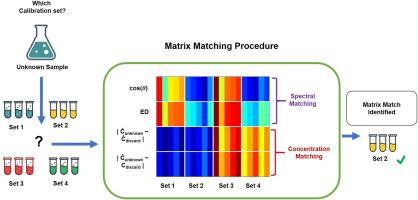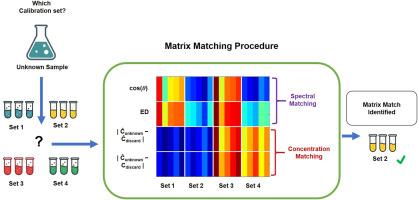基于多元曲线分解方法的矩阵匹配策略的矩阵效应评价
IF 6
2区 化学
Q1 CHEMISTRY, ANALYTICAL
引用次数: 0
摘要
分析化学中的多元校准模型由于样品组成和仪器条件的变化而经常受到基质效应的影响。这些影响带来了重大挑战,由于未知样品和校准数据集之间的光谱差异和浓度不匹配,往往导致预测不准确。现有的策略,如标准添加和局部建模,在同时处理这两个方面方面是有限的。迫切需要一种系统的方法,通过确保光谱相似性和浓度对齐来增强校准模型的鲁棒性,从而提高不同样本矩阵的预测精度。(89)结果采用多元曲线分辨率-交替最小二乘法(MCR-ALS)建立了一种矩阵匹配程序,以提高多元校准模型的准确性和鲁棒性。光谱匹配通过净分析物信号(NAS)投影和欧几里得距离进行评估,分离分析物和非分析物的贡献。此外,通过评估未知样品和校准集之间预测浓度范围的对齐来执行浓度匹配,确保不同样品组成的一致性。该方法使用模拟数据集和现实世界的分析数据进行了严格验证,包括玉米的近红外(NIR)光谱和酒精混合物的核磁共振(NMR)光谱。在所有测试场景中,矩阵匹配过程成功地确定了将矩阵效应最小化的最佳校准子集。该方法通过有效减少由光谱移位、强度波动和浓度不匹配引起的误差,大大提高了预测性能,在不同和复杂的矩阵中优于传统的校准策略。(140)意义:这种基于mcr - als的矩阵匹配框架通过系统地选择与未知样品在光谱和浓度上匹配的校准集来增强多元校准。通过最小化矩阵引起的误差,它确保了稳健和准确的预测。它具有跨分析平台的通用性和处理各种基质效应的能力,使其成为分析化学的宝贵工具,在现实世界的分析挑战中具有广泛应用的潜力。(60)本文章由计算机程序翻译,如有差异,请以英文原文为准。


Matrix effect assessment via matrix matching strategy using multivariate curve resolution methods
Background
Multivariate calibration models in analytical chemistry often suffer from matrix effects due to variations in sample composition and instrumental conditions. These effects present a major challenge, often resulting in inaccurate predictions due to spectral differences and concentration mismatches between unknown samples and calibration datasets. Existing strategies, such as standard addition and local modeling, are limited in addressing both aspects simultaneously. There is a critical need for a systematic approach that enhances calibration model robustness by ensuring spectral similarity and concentration alignment, thereby improving prediction accuracy across diverse sample matrices.
Results
We developed a matrix-matching procedure using Multivariate Curve Resolution–Alternating Least Squares (MCR-ALS) to enhance the accuracy and robustness of multivariate calibration models. Spectral matching is assessed via net analyte signal (NAS) projections and Euclidean distance, isolating analyte and non-analyte contributions. Additionally, concentration matching is performed by evaluating the alignment of predicted concentration ranges between unknown samples and calibration sets, ensuring consistency across varying sample compositions. The method was rigorously validated using both simulated datasets and real-world analytical data, including near-infrared (NIR) spectra of corn and nuclear magnetic resonance (NMR) spectra of alcohol mixtures. In all tested scenarios, the matrix-matching procedure successfully identified optimal calibration subsets that minimized matrix effects. This approach led to substantially improved prediction performance by effectively reducing errors caused by spectral shifts, intensity fluctuations, and concentration mismatches, outperforming conventional calibration strategies in diverse and complex matrices.
Significance
This MCR-ALS-based matrix-matching framework enhances multivariate calibration by systematically selecting calibration sets that match spectrally and in concentration with unknown samples. By minimizing matrix-induced errors, it ensures robust and accurate predictions. Its versatility across analytical platforms and ability to handle diverse matrix effects make it a valuable tool for analytical chemistry, with potential for broad application in real-world analytical challenges.
求助全文
通过发布文献求助,成功后即可免费获取论文全文。
去求助
来源期刊

Analytica Chimica Acta
化学-分析化学
CiteScore
10.40
自引率
6.50%
发文量
1081
审稿时长
38 days
期刊介绍:
Analytica Chimica Acta has an open access mirror journal Analytica Chimica Acta: X, sharing the same aims and scope, editorial team, submission system and rigorous peer review.
Analytica Chimica Acta provides a forum for the rapid publication of original research, and critical, comprehensive reviews dealing with all aspects of fundamental and applied modern analytical chemistry. The journal welcomes the submission of research papers which report studies concerning the development of new and significant analytical methodologies. In determining the suitability of submitted articles for publication, particular scrutiny will be placed on the degree of novelty and impact of the research and the extent to which it adds to the existing body of knowledge in analytical chemistry.
 求助内容:
求助内容: 应助结果提醒方式:
应助结果提醒方式:


